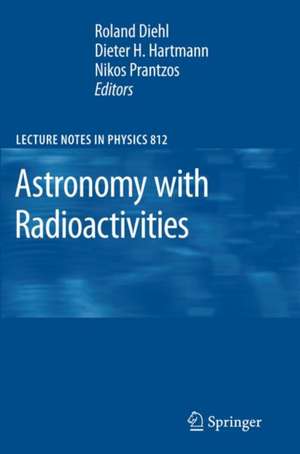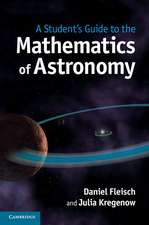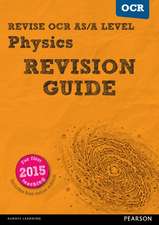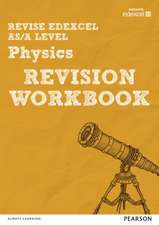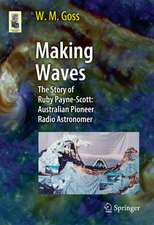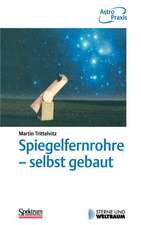Astronomy with Radioactivities: Lecture Notes in Physics, cartea 812
Editat de Roland Diehl, Dieter H. Hartmann, Nikos Prantzosen Limba Engleză Paperback – oct 2010
Din seria Lecture Notes in Physics
- 19%
 Preț: 423.99 lei
Preț: 423.99 lei - 17%
 Preț: 360.73 lei
Preț: 360.73 lei -
 Preț: 429.22 lei
Preț: 429.22 lei - 17%
 Preț: 427.62 lei
Preț: 427.62 lei - 17%
 Preț: 460.25 lei
Preț: 460.25 lei -
 Preț: 427.96 lei
Preț: 427.96 lei -
 Preț: 481.93 lei
Preț: 481.93 lei - 17%
 Preț: 494.64 lei
Preț: 494.64 lei -
 Preț: 281.90 lei
Preț: 281.90 lei - 17%
 Preț: 493.20 lei
Preț: 493.20 lei - 17%
 Preț: 426.72 lei
Preț: 426.72 lei -
 Preț: 365.15 lei
Preț: 365.15 lei -
 Preț: 374.52 lei
Preț: 374.52 lei -
 Preț: 407.98 lei
Preț: 407.98 lei - 20%
 Preț: 428.12 lei
Preț: 428.12 lei -
 Preț: 263.30 lei
Preț: 263.30 lei - 15%
 Preț: 593.73 lei
Preț: 593.73 lei - 15%
 Preț: 528.13 lei
Preț: 528.13 lei -
 Preț: 493.12 lei
Preț: 493.12 lei - 17%
 Preț: 425.68 lei
Preț: 425.68 lei -
 Preț: 280.65 lei
Preț: 280.65 lei -
 Preț: 163.41 lei
Preț: 163.41 lei - 18%
 Preț: 726.59 lei
Preț: 726.59 lei -
 Preț: 394.84 lei
Preț: 394.84 lei - 15%
 Preț: 709.63 lei
Preț: 709.63 lei - 15%
 Preț: 623.90 lei
Preț: 623.90 lei - 20%
 Preț: 476.91 lei
Preț: 476.91 lei - 15%
 Preț: 428.05 lei
Preț: 428.05 lei -
 Preț: 342.78 lei
Preț: 342.78 lei - 18%
 Preț: 851.93 lei
Preț: 851.93 lei -
 Preț: 346.61 lei
Preț: 346.61 lei -
 Preț: 391.57 lei
Preț: 391.57 lei - 15%
 Preț: 633.16 lei
Preț: 633.16 lei -
 Preț: 451.71 lei
Preț: 451.71 lei - 5%
 Preț: 1497.80 lei
Preț: 1497.80 lei -
 Preț: 374.85 lei
Preț: 374.85 lei -
 Preț: 380.07 lei
Preț: 380.07 lei - 15%
 Preț: 516.14 lei
Preț: 516.14 lei - 15%
 Preț: 583.78 lei
Preț: 583.78 lei - 15%
 Preț: 508.60 lei
Preț: 508.60 lei -
 Preț: 469.71 lei
Preț: 469.71 lei -
 Preț: 388.90 lei
Preț: 388.90 lei - 15%
 Preț: 500.24 lei
Preț: 500.24 lei -
 Preț: 386.52 lei
Preț: 386.52 lei - 15%
 Preț: 472.88 lei
Preț: 472.88 lei -
 Preț: 424.27 lei
Preț: 424.27 lei -
 Preț: 380.07 lei
Preț: 380.07 lei - 15%
 Preț: 500.01 lei
Preț: 500.01 lei
Preț: 663.09 lei
Preț vechi: 872.48 lei
-24% Nou
Puncte Express: 995
Preț estimativ în valută:
126.88€ • 132.75$ • 105.40£
126.88€ • 132.75$ • 105.40£
Carte tipărită la comandă
Livrare economică 29 martie-04 aprilie
Preluare comenzi: 021 569.72.76
Specificații
ISBN-13: 9783642126970
ISBN-10: 3642126979
Pagini: 580
Dimensiuni: 155 x 235 x 37 mm
Greutate: 0.79 kg
Ediția:2011
Editura: Springer
Colecția Springer
Seria Lecture Notes in Physics
Locul publicării:Berlin, Heidelberg, Germany
ISBN-10: 3642126979
Pagini: 580
Dimensiuni: 155 x 235 x 37 mm
Greutate: 0.79 kg
Ediția:2011
Editura: Springer
Colecția Springer
Seria Lecture Notes in Physics
Locul publicării:Berlin, Heidelberg, Germany
Public țintă
ResearchCuprins
Part
I
The
Role
of
Radioactivities
in
Astrophysics.-
Introduction
to
Astronomy
With
Radioactivity.-
The
Role
of
Radioactive
Isotopes
in
Astrophysics.-
Part
II
Specific
Sources
of
Cosmic
Isotopes.-
Radioactivities
in
Low-and
Intermediate-Mass
Stars.-
Massive
Stars
and
their
Supernovae.-
Binary
Systems
and
Their
Nuclear
Explosions.-
Part
III
Special
Places
to
Observe
Cosmic
Isotopes.-
Distributed
Radioactivities.-
Part
IV
Tools
for
the
Study
of
Radioactivities
in
Astrophysics.-
Nuclear
Reactions.-
Instruments
for
Observations
of
Radioactivities.-
Part
V
Epilogue.-
Perspectives.-
Annotations
on
Chemical
Evolution.-
Radionuclides
and
Their
Stellar
Origins.-
Milestones
in
the
Science
of
Cosmic
Radioactivities.-
Glossary:
Key
Terms
in
Astronomy
With
Radioactivities.-
Index.
Textul de pe ultima copertă
This
book
introduces
the
reader
to
the
field
of
nuclear
astrophysics,
i.e.
theacquisition
and
reading
of
measurements
on
unstable
isotopes
in
different
parts
ofthe
universe.
The
authors
explain
the
role
of
radioactivities
in
astrophysics,
discuss
specific
sources
of
cosmic
isotopes
and
in
which
special
regions
they
can
be
observed.
More
specifically,
the
authors
address
stars
of
different
types,
stellar
explosions
whichterminate
stellar
evolutions,
and
other
explosions
triggered
by
mass
transfers
and
instabilitiesin
binary
stars.
They
also
address
nuclear
reactions
and
transport
processesin
interstellar
space,
in
the
contexts
of
cosmic
rays
and
of
chemical
evolution.
Aspecial
chapter
is
dedicated
to
the
solar
system
which
even
provides
materialsamples.
The
book
also
contains
a
description
of
key
tools
which
astrophysicists
employ
in
thoseparticular
studies
and
a
glossary
of
key
terms
in
astronomy
with
radioactivities.
Caracteristici
Gives
a
comprehensive
and
coherent
account
of
the
growing
field
of
nuclear
astropyhsicsPresents
state-of-the-art
understanding
of
how
nature
made
the
elements
we
are
composed
ofContains
extremely
useful
appendices
listing
and
explaining
Radionuclides
and
their
Stellar
OriginsMilestones
in
the
Science
of
Cosmic
RadioactivitiesContains
a
glossary
of
Key
Terms
in
Astronomy
with
Radioactivities
Descriere
This
comprehensive
and
coherent
book
introduces
the
reader
to
the
field
of
nuclear
astrophysics.
The
authors
explain
the
role
of
radioactivities
in
astrophysics,
discuss
specific
sources
of
cosmic
isotopes
and
in
which
special
regions
they
can
be
observed.
